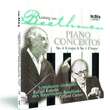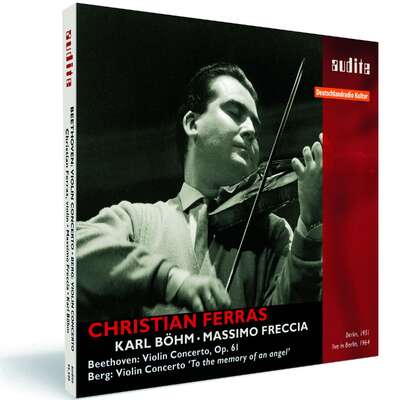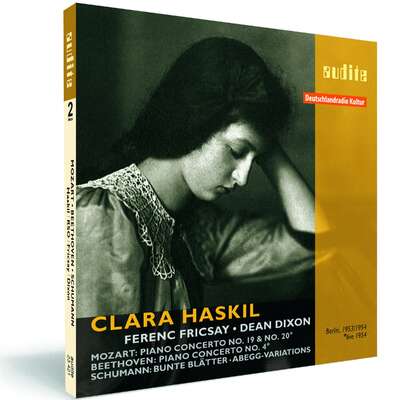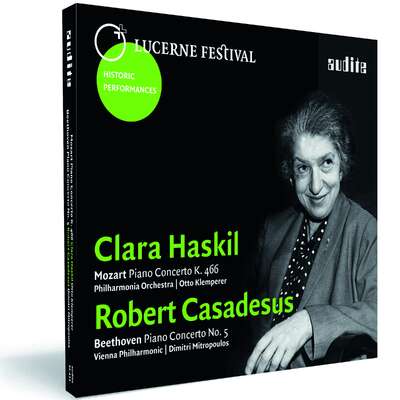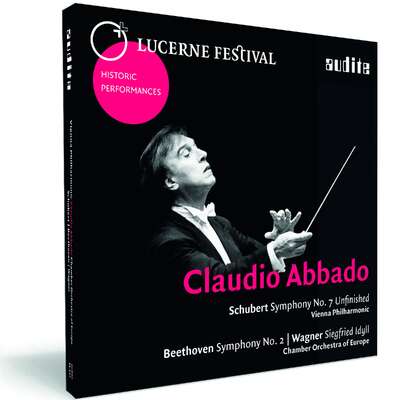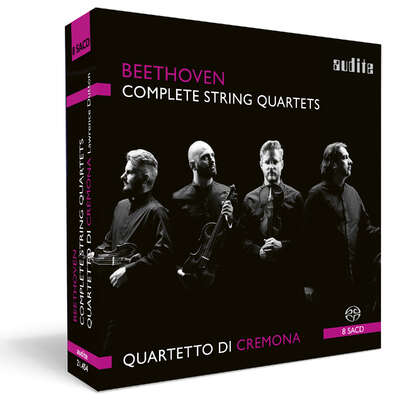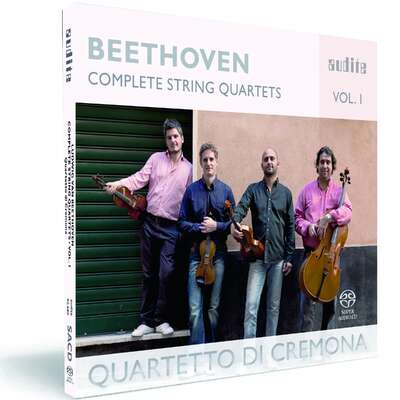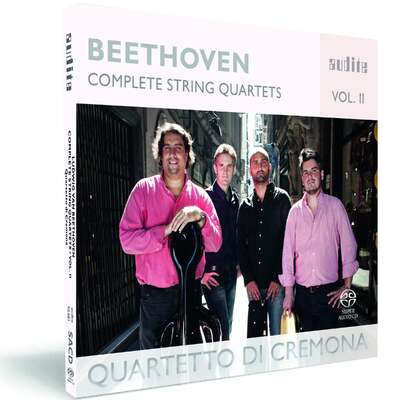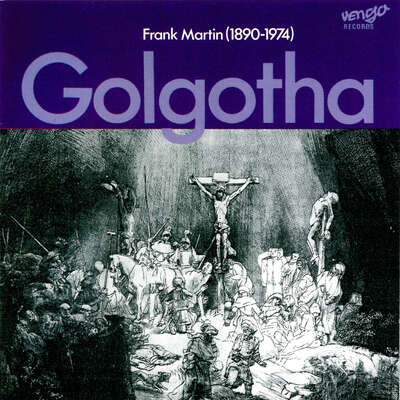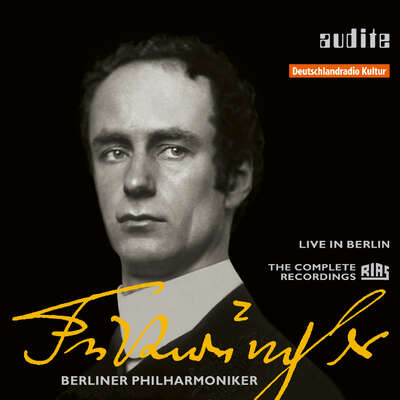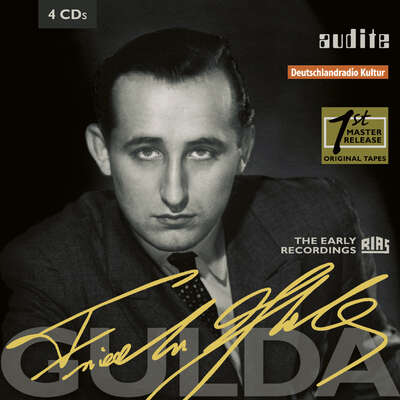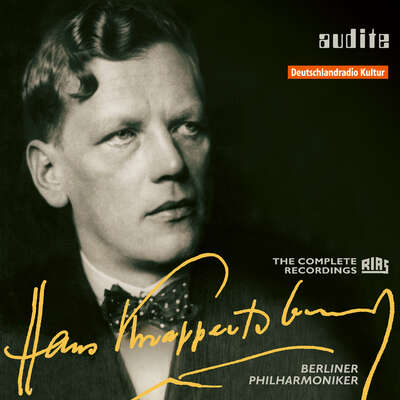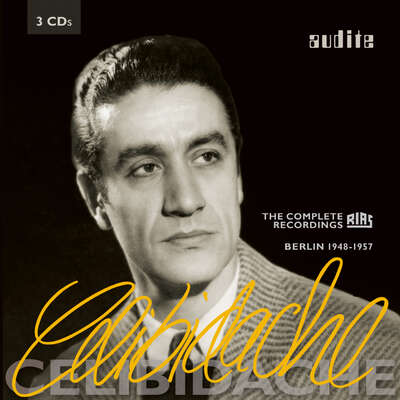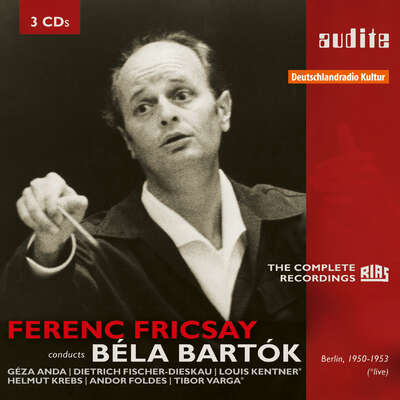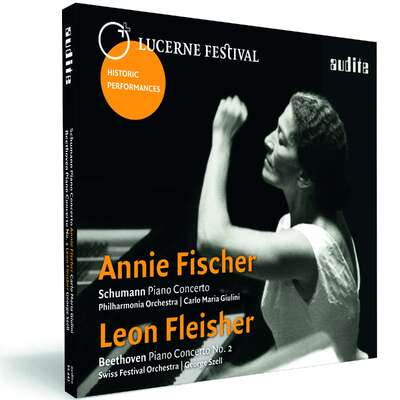
"Die Zusammenarbeit der miteinander eng befreundeten Künstler zeigte außergewöhnliche Resultate..." (Klassik heute)
Details
| Ludwig van Beethoven: Piano Concertos No. 4 & No. 5 | |
| Artikelnummer: | 95.459 |
|---|---|
| EAN-Code: | 4009410954596 |
| Preisgruppe: | BCB |
| Veröffentlichungsdatum: | 1. Januar 1998 |
| Spielzeit: | 76 min. |
Besprechungen
Fanfare | 01.05.2010 | 1. Mai 2010
This release is tagged Volume 7 in Audite’s ongoing series devoted to Karl Böhm. The concerto is a live account dating from 1950 and may well proveMehr lesen
CD Compact | n°174 (marzo 2004) | Francisco Javier Aguirre | 1. März 2004 Audite/Rafael Kubelik
El intenso patriota que fue este director checo, celebró el regreso a suMehr lesen
El País
| 19.04.2003 | Javier Pérez Senz | 19. April 2003
Kubelik, en el corazón de Mahler
Dos sinfonías de Gustav Mahler grabadas en vivo abren la edición que el sello Audite dedica al director checo Rafael Kubelik, uno de los grandes mahlerianos de la historia.
[...] dirige el célebre adagietto con un encendido lirismo y una intensidad que hipnotiza al oyente –, situándose entre las mejores de la discografía.Mehr lesen
The Mail on Sunday | 27th October 2002 | David Mellor | 27. Oktober 2002
Most CDs would not be missed if they were locked away in a vault never toMehr lesen
American Record Guide | 01/2001 | John P. Mckelvey | 1. Januar 2001
Clifford Curzon was a finicky perfectionist who never liked the recording process and never seemed satisfied with his recorded performances, howeverMehr lesen
Curzon recorded expressive and powerful accounts of these two concertos with Knappertsbusch and the VPO in the mid-1950s. They are scheduled to be released soon on a low-cost Decca CD. Why, then, do we need these items from Audite?
Well, simply because these 1977 performances are even more poetic, grandly shaped, spontaneous, luminous, splendidly proportioned, and totally effective than the earlier ones. What is more, Kubelik and his great orchestra supply as sensitive and romantically supportive an orchestral backing as one could imagine--a framework for Curzon\'s pianism even more elegant than the formidable Knappertsbusch manages. Also, the sound here, though exhibiting less warmth and resonance than one expects from the Herculessaal, is more spacious, better focussed, and precisely imaged than in the earlier issue. Curzon is more expansive, and his sensitive and poetic shaping of phrases and paragraphs puts this release right into the top drawer. This is most impressive in No. 4, a work that is clearly structured on a Mozartean model. The Emperor is a little more straightforward, though still grandly proportioned and nobly expressed. Curzon\'s runs and trills are often slightly uneven, intentionally so I think, to give each of them i ts unique and individual profile. The uniquely poetic quality of these readings really puts them in a class by themselves. This is a full-price release, and it is worth far more than the asking price. It demonstrates this artist\'s work at its best.
Diapason | Juillet-Août 2000 | Etienne Moreau | 1. Juli 2000
Il est fascinant de constater grâce au disque combien certains artistes ont pu évoluer au cours de leur carrière, particulièrement dans le casMehr lesen
Le Monde de la Musique | Juillet-Août 2000 | Patrick Szersnovicz | 1. Juli 2000
Chef-d’œvre quasi miraculeux, le Quatrième Concerto en sol majeur op. 58 (1803-1806) subjugue par l'élégance et la perfection de son tissuMehr lesen
Enregistrés en concert public avec l'Orchestre symphonique de la Radio bavaroise, Clifford Curzon et Rafael Kubelik défendent une même vision apollinienne, faite de sérénité et de probité. Le jeu coloré, subtil et souplement phrasé du pianiste magnifie la lyrique si particulière au Concerto en sol, ce mélange de songe et d'exaltation romantique. L'accompagnement de Kubelik, d'une intériorité presque aussi remarquable, pénètre avec simplicité au cœur de l'œuvre mais n'empêche nullement une certaine tension dramatique. Cette lumineuse entente se poursuit dans L'Empereur, où Curzon, privilégiant une lecture étonnamment contrôlée, partage avec le chef une conception grandiose et lucide héritée de son maître Artur Schnabel et d'autant plus souveraine qu’elle semble née d’une rigueur complice.
Répertoire | Juin 2000 | Pascal Brissaud | 1. Juni 2000
Les fans du grand (et rare au disque) pianiste britannique Clifford CurzonMehr lesen
Applaus | 4/2000 | Martina Kausch | 1. April 2000
Großes Staunen
Live-Mitschnitte von Mahler- und Mozart-Konzerten unter Rafael Kubelik beweisen einmal mehr den Rang des BR-Symphonie-Orchesters
Im Jubeljahr des 50-jährigen Bestehens ist die Edition von Aufnahmen desMehr lesen
La lettre du Musicien | 2000-2001 | JB | 1. Januar 2000
Le grand pianiste anglais Clifford Curzon (1907- 1982) n'a jamais étéMehr lesen
www.ClassicsToday.com | 01.01.1999 | Dan Davis | 1. Januar 1999
Hard on the heels of Audite's Mozart Concerto disc (Audite 95453) withMehr lesen
Klassik heute | Dezember 1998 | Matthias Thiemel | 1. Dezember 1998
Clifford Curzon (1907-1982) war Schüler u.a. von Arthur Schnabel und WandaMehr lesen
Gramophone | Gramophone Awards | Geoffrey Norris Emerging triumphant from the flames
It was shunned at its premiere but Beethoven's Fourth Piano Concerto – wildly radical for its time – is now championed by countless performers.Mehr lesen
It's a chilly December evening in Vienna. A good-sized audience has braved the cold and gathered in the unheated Theater an der Wien for a marathon benefit concert featuring the radical composer whom everyone is talking about. He's a bit of an odd ball – often irascible, not a great socialiser, inclined to put people's backs up – but a lot of the music he writes is worth hearing, and he can be relied upon to come up with a surprise or two. Tonight the man himself is going to appear as soloist in his latest piano concerto and, it's rumoured, will do some improvisation in a new piece called Choral Fantasy, which he has knocked together in a hurry because he suddenly realised that a chorus was already on hand to sing parts of his Mass in C. There are to be premieres of two symphonies – his Fifth and Sixth – and a young soprano is standing in at the last moment to sing the scena and aria Ah! Perfido, the composer apparently having had a row with the diva originally booked.
The year was 1808. Beethoven sat down at the keyboard for his Fourth Piano Concerto, which he had already played the previous year at the palace of his well-disposed patron Prince Franz Joseph Maximilian von Lobkowitz. But this was the first time it had been heard by the paying Vienna public. All heads turned towards the conductor for a sign that he was going to give a downbeat for the orchestral introduction. That, after all, was the norm in a concerto in that day and age, but the composer played a quiet G major chord followed by a little questioning phrase, and it was only then that the orchestra came in. What was going on? Back in the 1770s, Mozart had done something similarly unexpected in the Concerto in E flat, K271, but even there the orchestra had the first say. More to the point, the new concerto was not riveting or dynamic: it was more as if the composer were poetically communing with himself. Minds wandered. The public were accustomed to sitting through long concerts, but the four hours and more of this one were taking things a bit far. The audience eventually trooped out of the theatre into the bitter Vienna night, frozen to the marrow and feeling short-changed.
As if that weren’t enough…
The uncomprehending reception of the Fourth Piano Concerto was just one of the misfortunes to beset this all-Beethoven night on December 22, 1808: the orchestra, ill-rehearsed and annoyed with Beethoven over some earlier misdemeanour, fell apart in the Choral Fantasy and the piece had to be started again. And far from being a benefit night for Beethoven, it is thought that he hardly managed to break even. The G major Concerto never really entered the core repertoire until Mendelssohn – that youthfully perceptive and vigorous campaigner on behalf of unjustly neglected causes, Bach included – rescued it in the 1830s. Clara Schumann took it up in the 1840s. In the 1860s Hans von Billow played it. Anton Rubinstein played it. Liszt admired it. The Fourth gradually overcame its unpromising entry into the world – as such ground breaking and unusual music is so often prone to do – and entered the canon of Beethoven's regularly performed concertos. These days its reception is immeasurably more favourable than that which its first audience was prepared or equipped to give it, and there is no shortage of recordings in the current catalogue. From a long list, I have selected for this comparative review 20 versions that represent some of the great names of the past and a cross-section of the young and seasoned artists of today.
From the earlier era there are Artur Schnabel (recorded 1933), Willhelm Backhaus (1950), Claudio Arrau (1957), Emil Gilels (1957), Wilhelm Kempff (1961), Daniel Adni (1971) and Clifford Curzon (1977). From more recent times, Maurizio Pollini (1992, as well as 1976), Alfred Brendel (1997), Pierre-Laurent Aimard (2002), Daniel Barenboim (2007, plus 1967), Evgeny Kissin (2007), Lang Lang (2007), Till Fellner (2008), Paul Lewis (2009) and Yevgeny Sudbin (2009). In a special category, Arthur Schoonderwoerd (2004) plays a period Johann Fritz piano; and on a modern Steinway Ronald Brautigam (2007) adopts Beethoven's revisions as published by Barry Cooper in 1994.
The matter of time
There is a whole world of difference here between, at the one extreme, the versions by Claudio Arrau, Daniel Adni and the earlier of Daniel Barenboim's two (all of them conducted by Otto Klemperer) and, at the other end, Brautigam's performance with the Norrköping Symphony Orchestra under Andrew Parrott. Whereas Klemperer exploits the full sumptuousness of the (New) Philharmonia Orchestra and takes about 20 minutes to negotiate the first movement, Parrott adopts 'period aware' thinking and sharper pacing with scant vibrato, and clocks up a running time of about 17 minutes for the first movement. That is about the norm in most of the recordings apart from Klemperer's, and, eminent though his performances are, the music does exude an air of lingering in a way that would certainly not have appealed to that first Vienna audience in 1808. Pierre-Laurent Almard with the Chamber Orchestra of Europe under Nikolaus Harnoncourt, Lang Lang with the Orchestre de Paris under Christoph Eschenbach and Evgeny Kissin with the London Symphony Orchestra under Sir Colin Davis all demonstrate a slowness in this first movement – but it doesn't necessarily lead to languor. At times, however, it's a close-run thing, and in other versions the music certainly has more of a lift and a natural flow. Daniel Barenboim, conducting the Staatskapelle Berlin from the keyboard, shaves off just over a minute from the time he took under Klemperer, and the result is a performance that has power, concentration and crucial momentum.
Ronald Brautigam's pacing comes in at about the average, and his recourse to Beethoven's revisions is an interesting facet of his polished and discreetly shaped interpretation: the addition of more florid passages and extra notes and some chopping and changing of register lend the concerto a different perspective – more decorative and, in Cooper's words, 'strikingly inventive and more sparkling, virtuosic and sophisticated than the standard one'. Since these revisions are in Beethoven's own hand on the copyist's orchestral score, it is likely that he himself played it in much this way at the 1808 concert, though other artists have not yet followed his or Brautigam's example, at least on disc.
Going the whole hog in speculative performance practice, Arthur Schoonderwoerd on his fortepiano of 1805-10 actually comes in as the quickest exponent of the first movement by the stopwatch, but curiously he also sounds the most effortful, and those wiry, nasal old instruments in the reduced orchestral ensemble of Cristofori are very much an acquired taste.
If it is probably wise to eliminate Klemperer's three recordings from the final reckoning in terms of repeated listening, Artur Schnabel's 1933 performance is testament both to his brilliant artistry and to his characterful interpretative style. The remastered sound is not at all bad, and the relationship with the London Philharmonic Orchestra under (the not then Sir) Malcolm Sargent is secure and spontaneous. One might baulk at the slight ratcheting up of tempo when the piano re-enters at bar 74 of the first movement: Sargent faithfully adheres to the speed that Schnabel suggests during his opening phrase, but Schnabel then decides that he wants things to go a bit quicker after the long orchestral tutti. There are also some orchestral glissandi that speak of the practice at the time when this recording was made, but they do not unduly obtrude and the performance is one of infectious spirit, even if the finale does sometimes threaten to break free of its leash. Of the other 'historical' performances, Wilhelm Backhaus's with the RIAS Symphony Orchestra under Karl Böhm is of an impressive seriousness and eloquence of expression. The Fourth, recorded live in Berlin, was a favourite concerto of Backhaus, one in which he manifested his reputation as a 'devotedly unselfish mouthpiece' for the composers he was playing. This by no means implies a lack of imagination, for Backhaus's performance is one that combines serenity and vitality and also conveys a sure grasp of the concerto's structure. So, too, do Alfred Brendel and the Vienna Philharmonic under Simon Rattle, and Maurizio Pollini in characteristically translucent yet powerful fashion with the Berlin Philharmonic under Claudio Abbado and earlier on with the Vienna Philharmonic under Böhm. From more recent times, there are similarly well-reasoned performances from Till Fellner with the Montreal Symphony Orchestra under Kent Nagano, Paul Lewis with the BBC Symphony Orchestra under Jirí Belohlávek and Yevgeny Sudbin with the Minnesota Orchestra under Osmo Vänskä. I cannot pretend that comparisons between any of these make the choice of a preferred version any easier: all of them have searching qualities and interpretative personalities that seem to be in harmony with the music's disposition.
The cadenza issue
Alfred Brendel's performance does, however, raise the interesting question of the cadenzas. Beethoven wrote two for the first movement and one for the last. Many other composers and pianists have supplied their own over the years, including Brahms, Busoni, Godowsky, Saint-Saens and Clara Schumann. Wilhelm Kempff preferred to use his own cadenzas for his recording with the Berlin Philharmonic under Ferdinand Leitner, as does Arthur Schoonderwoerd with Cristofori. Other pianists are divided, if not equally, between Beethoven's two first-movement cadenzas. The one most commonly favoured begins in 6/8 with a quickened-up version of the opening theme in repeated Gs in the right hand. The other, starting with soft octave Gs in the left hand, builds to a swift climax and a torrent of descending thirds. Alfred Brendel and Maurizio Pollini are among the proponents of this more ominous, wilder – if shorter – cadenza, and in his book Music Sounded Out (1995, page 57) Brendel gives his reasons. 'May I assure all doubting Thomases', he says, 'that the cadenza I play in the first movement of the Fourth Concerto is indeed Beethoven's own; the autograph has the superscription Cadenza ma senza cadere ['Cadenza, but without falling down'] ' an allusion to its pianistic pitfalls. I have often been asked why I should waste my time on this bizarre piece when another more lyrical, and plausible, cadenza is available. I think that the [superscription) adds something to our knowledge of Beethoven. It shows almost shockingly how Beethoven the architect could turn, in some of his cadenzas, into a genius running amok. Almost all the classical principles of order fall by the wayside, as comparison with Mozart's cadenzas will amply demonstrate. Breaking away from the style and character of the movement does not bother Beethoven at all, and harmonic detours cannot be daring enough. No other composer has ever offered cadenzas of such provoking madness.' If someone else had written this weird cadenza, he or she would surely have been roundly condemned for shattering the mood of the first movement, but, as it is, it is there as an entirely justifiable option. Brendel's performance of it certainly underlines his point about Beethoven's genius running amok, and the cadenza delivers a similar blow to the senses in the two recordings by Maurizio Pollini. If the choice of the first-movement cadenza is a major factor in your enjoyment of the Fourth Concerto, then this needs to be taken into account. Backhaus, incidentally, plays the 'usual' Beethoven cadenza in the first movement, but his own stormy, bravura one in the finale.
There is one recording that has not so far been mentioned. In an effort to keep up the suspense about the ultimate choice in this Fourth Piano Concerto (though the boxes scattered about this review will already have given more than a clue), I have not yet put forward the name of Emil Gilels. Strictly speaking, his recording comes in the historical category, since it was made in 1957 with the Philharmonia Orchestra under Leopold Ludwig, but its sound is exceptionally well remastered and it is a performance of transcendent beauty allied to power, delicacy, control and a palette of colour – both in the piano and in the orchestra – that is second to none. Gilels was in his maturity when he made this sublime recording (coupled with the Fifth Concerto) at the age of 41, and it testifies to the stylistic understanding and thoughtful qualities that distinguished his piano-playing at its best. The first movement is eloquently voiced – 'poetry and virtuosity are held in perfect poise', as a Gramophone review rightly put it; and he gives a vibrant account of the wilder first-movement cadenza that Brendel and Pollini also prefer.
Pinning all one’s hopes on the slow movement
When it comes to the short slow movement, the dialogue between the aggressive orchestra and the ameliorating piano is judged immaculately and poignantly by Ludwig and Gilels.It was the critic Adolf Bernhard Marx who (in 1859) propounded the theory that this movement could be viewed as an analogy of Orpheus pacifying the Furies at the gates of Hades, a romantic notion that has held sway ever since. Whatever was in Ludwig's and Gilels's minds, the orchestra's gradual acquiescence under the piano's gently persuasive influence is pure magic. By contrast, on Clifford Curzon's recording with the Bavarian Radio Symphony Orchestra under Rafael Kubelik – a performance that is otherwise of great distinction – the orchestra sounds merely a bit blunt rather than hostile. Nagano has his Montreal Symphony Orchestra tripping lightly on Fellner's recording; Böhm sounds ominous, if a little ponderous, for Backhaus, though Backhaus's own playing is melting. Leitner gives something appropriately stern for Kempff to answer on his recording. Sargent's crisp note values observe the sempre staccato marking at the start of the slow movement and thus give the music more bite for Schnabel. Belohlávek and Lewis also manage this discourse effectively, as do Rattle and Brendel. It is debatable whether either Abbado or Böhm on Pollini's recordings makes adequate distinction between the two parties in the same, almost visually palpable, way that Ludwig and Gilels do, and on Sudbin's otherwise first-rate recording Vänskä coaxes a surprisingly soft-edged attack from the Minnesota Orchestra at this juncture.
It is odd, perhaps, that after barely being able to put a pin between a good many of the available recordings of the Fourth Concerto, so much should hinge on how the orchestra reacts to the piano in the slow movement, and vice versa. The finales do not disappoint in any of the leading versions, but with the slow movement proving to be, if subjectively, a point where some performances are more clearly defined in impact than others, the final choice would seem to rest on five versions: Backhaus and Böhm with the RIAS Symphony Orchestra from 1950, Gilels with the Philharmonia Orchestra under Ludwig from 1957, Kempff with the Berlin Philharmonic and Leitner from 1961, Brendel and Rattle with the Vienna Philharmonic from 1997 and Lewis with Belohlávek and the BBC Symphony Orchestra from 2009. In addition, there is an irresistible élan to Schnabel's 1933 performance with the London Philharmonic Orchestra under Sargent, and much of textural and interpretative interest in the 2007 version by Brautigam and the Norrköping Symphony Orchestra under Parrott.
The last of these, being the only one to adopt Beethoven's manuscript revisions to the concerto, comes across with a different sort of scintillating zest that is particularly attractive, and the disc (with the piano arrangement of the Violin Concerto as coupling) could be a refreshing addition for anybody wanting a companion to a recording of the received version. Schnabel, Backhaus and Kempff in their different ways bring timeless musicianship to their interpretations, but the mix of vitality and visionary expressiveness in the Backhaus just gives that one the edge – remembering, though, that he plays his own cadenza in the finale. With the recording by Brendel and Rattle (Brendel's third recording of the Fourth Concerto, the others being with Bernard Haitink and James Levine) there is a true meeting of musical minds, the orchestra and piano establishing a mutual understanding of their roles in the expressive and dynamic scheme of things. The interpretative bond between Lewis and Belohlávek is similarly a close and fertile one and has forged not only a compelling performance of the Fourth Concerto but also a complete set of all five. But when it comes down to it, the special qualities of Gilels – his poetry, power and poise – put him prominently in prime place.
